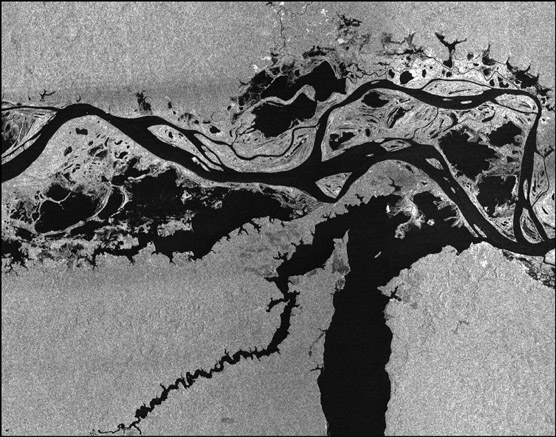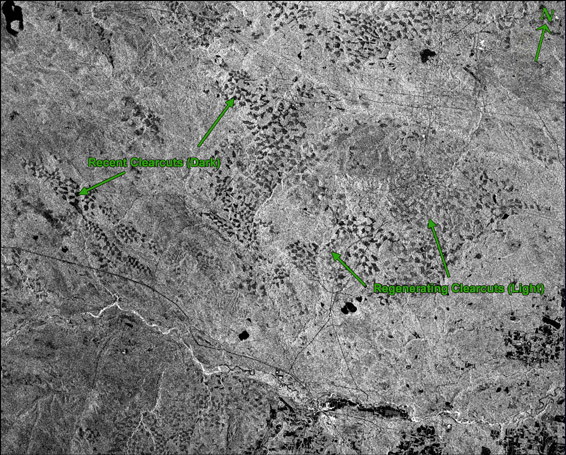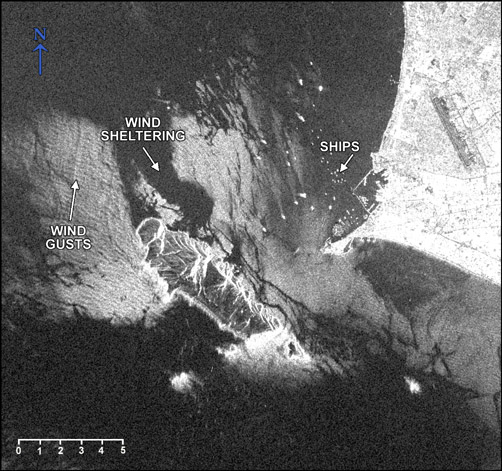Applications
The many advances in RADARSAT-1 technology were developed to respond to specific needs for radar data in hundreds of environmental monitoring applications in Canada and around the world. Through programs, conferences and funding opportunities, applications are being developed all the time. This is an overview of the main RADARSAT-1 Earth observation data applications.
Ice

RADARSAT data © Canadian Space Agency (CSA) . Received by the Canada Centre for Remote Sensing. Processed and distributed by MacDonald, Dettwiler and Associates Ltd. (MDA)
RADARSAT-1 provided routine surveillance of the entire Arctic region. This helped to track sea ice distribution, identify various types of ice, and produce daily ice charts. The information was used for planning safe shipping routes and supply operations for offshore exploration platforms or ocean research stations. RADARSAT has also helped update maps of Antarctica and monitor Antarctic ice fields.
Environment monitoring

RADARSAT data © Canadian Space Agency (CSA) 1996. Received by the Canada Centre for Remote Sensing. Processed and distributed by MacDonald, Dettwiler and Associates Ltd. (MDA)
Because the RADARSAT-1 SAR penetrated heavy cloud cover, many of the world's rain forests and coastal regions could be mapped effectively. RADARSAT-1 could also monitor the extent of marine oil spills, providing vital information for spill control and clean up operations, and have considerable value in settling legal questions related to oil spills.
Disaster management
Radar satellites are key resources in a variety of disaster management scenarios. The coordination of international satellite resources for disaster response efforts is managed by the International Charter on Space and Major Disasters, of which Canada is a long-time member and data contributor.
The data has been used effectively in disaster responses such as earthquakes, tsunamis, floods, landslides, forest fires, and other natural or technological disasters. The ability to deliver data in near-real time is essential for relief operations to map and monitor damage and for assessing the impact on the future.
RADARSAT-1 reduces planning lead times for data acquisition, and its left- and right-looking modes provide more revisits and up-to-date data.
Hydrology

RADARSAT data © Canadian Space Agency (CSA) 1996. Received by the Canada Centre for Remote Sensing. Processed and distributed by MacDonald, Dettwiler and Associates Ltd. (MDA)
Many applications were developed to take advantage of RADARSAT-1 capacity for detecting the presence of water. These included monitoring flooding and the build-up of river ice, and mapping the melting of snow-covered areas.
As the image shows, RADARSAT-1 provided excellent land/water delineation. In this image, the forest cover and floodplain appear in tones of grey, while the water is distinctly black. The forests along the Amazon River and nearby lakes in Brazil experience seasonal flooding, and with the use of multi-temporal RADARSAT-1 images, these areas could be mapped.
When used for flood monitoring, RADARSAT-1 data helped assess the impact of flooding, predicted the extent and duration of floodwaters, analyzed the environmental impact of water diversion projects, and developed flood mitigation measures.
Geology

RADARSAT data © Canadian Space Agency (CSA) 1996. Received by the Canada Centre for Remote Sensing. Processed and distributed by MacDonald, Dettwiler and Associates Ltd. (MDA)
Many significant geological structural features were mapped using RADARSAT-1. By mapping features such as faults, folds, and lineaments we obtained new information on groundwater distribution, economic mineral deposits, and the potential for oil and gas deposits. RADARSAT-1 imagery also helped to identify appropriate sites for hazardous waste. In addition, seismic and fault data from RADARSAT-1 imagery was used for studies on the nature and causes of earthquakes.
The many alluvial fans found in the Balochistan Desert in western Pakistan show in very light tones in the lower part of this RADARSAT image. The dark area is the structural depression that separates the Chagai Hills from the Ras Koh Range. Wet flood plains and areas covered with thin layers of salt also have a dark appearance.
Agriculture

RADARSAT data © Canadian Space Agency (CSA) 1996. Received by the Canada Centre for Remote Sensing. Processed and distributed by MacDonald, Dettwiler and Associates Ltd. (MDA)
Using RADARSAT-1 imagery, agricultural planners could examine and assess crop characteristics and planting practices and could better forecast crop yields. Under favourable conditions, soil characteristics such as moisture content and surface roughness could be identified. These help determined crop conditions, susceptibility to erosion, and irrigation needs.
This RADARSAT-1 image of Zhaoqing, China is an integration of Standard and Fine beam mode images. The colours show different types of vegetation and various crop growth stages. Aquaculture sites and flooded rice paddies appear as very dark and black, while the village areas and banana fields are very light coloured.
Forestry

Text version - graphic about forestry
RADARSAT imagery of the forestry
- Recent clearcuts (dark)
- Regenerating clearcuts (light)
RADARSAT data © Canadian Space Agency (CSA) 1996. Received by the Canada Centre for Remote Sensing. Processed and distributed by MacDonald, Dettwiler and Associates Ltd. (MDA)
RADARSAT-1 provided valuable data to help map and monitor the world's forests. Using these data, accurate maps of clear cuts in boreal and tropical forests could be created to assess environmental impacts and measure the success of replanting operations.
This RADARSAT-1 image of Whitecourt, Alberta, Canada shows the extensive clearcutting of boreal forest that has occurred in this region. Recent clearcuts are quite visible as dark areas, while regenerating clearcuts, seen as grey tones, are harder to distinguish from the light tones of the remaining boreal forest.
Coastal waters and open oceans

Text version - graphic about coastal waters and open oceans
RADARSAT imagery of the coastal waters and open oceans
- Cardinal points - North
- Wind gusts wind shelterring
- Ships
- Map scale
RADARSAT data © Canadian Space Agency (CSA) 1996. Received by the Canada Centre for Remote Sensing. Processed and distributed by MacDonald, Dettwiler and Associates Ltd. (MDA)
RADARSAT-1 imagery was an important source of new data for the world's oceans and coastal regions. Regardless of cloud, fog, or darkness, RADARSAT-1 could accurately measure changes in ocean waves and winds—information that was useful for offshore oil exploration, ocean research operations, and locating potentially productive fishing areas.
The dark tones in this RADARSAT-1 image, taken off the coast of Callao, Peru, are due to the decreased surface roughness by the wind lee effects. The lighter patches show where the wind has increased the surface roughness of the water. Ships appear as very bright spots in this image.